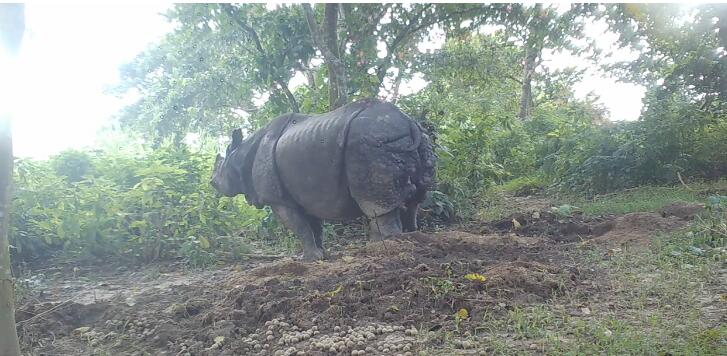A successful reintroduction program has been implemented for the greater one-horned rhinos in Nepal over the past few decades. However, few studies have investigated recovery of function following reintroduction.
In a study published in Biological Conservation, researchers from Xishuangbanna Tropical Botanical Garden (XTBG) and their collaborators examined the impact of the greater one-horned rhinoceros (Rhinoceros unicornis) reintroduction on restoring their ecological function, specifically their interactions with other mammals and birds via their dung (latrines).
The study was conducted at two sites in Nepal: Chitwan National Park, where a stable rhino population resides, and Shuklaphanta National Park, where a rhino reintroduction program was implemented from 2003 to 2018.
The researchers investigated whether rhino reintroduction has restored the ecological function of rhino latrines as a food source for other animals. They set up camera traps in the two parks. They monitored visitors to 30 rhinoceros latrines in both parks during 669 camera trap days between 2020 and 2021. They then compared species richness and visitation rates of mammals and birds interacting with rhinoceros latrines between the two sites and recorded how often animals visited the latrines and their behavior on them.
They found that there were no significant differences in species richness of latrine visitors or most behavior frequencies at latrines, despite large differences in rhino abundance between sites, as well as differences in latrine size, quality, and some nutrient contents. Animal visitation rates were higher at the site where rhinos had been reintroduced, confirming that latrines are an important and limited resource.
They observed 4 mammalian and 4 avian species utilized rhino dung for feeding on insects or plants growing around the dung; an additional two mammalian species interacted with latrines only indirectly.
"Our study provides strong evidence that rewilding of rhinos can restore the function of latrines as nutrient hotspots for other organisms.Therefore, reintroduction of large-bodied animals can mitigate ecosystem deterioration,”said CHEN Jin of XTBG.
Contact
CHEN Jin Ph.D Principal Investigator
Key Laboratory of Tropical Forest Ecology, Xishuangbanna Tropical Botanical Garden, Chinese Academy of Sciences, Mengla, Yunnan 666303, China
E-mail: cj@xtbg.org.cn
Published: 11 May 2024

The greater one-horned rhinocero reintroduced to the wild. (Image by XTBG)

